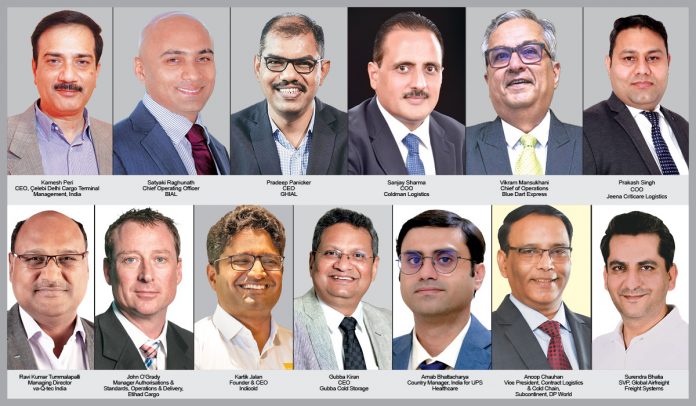India’s current cold chain market size is at US$35 billion and is likely to reach US$50 billion by 2027. Any deviation in temperature control can compromise product integrity. Minimising temperature deviations during loading, unloading, and transfer processes is also critical to maintain cold chain integrity.
Ritika Arora Bhola
The Indian cold chain sector has grown in the past few years, looking at the surge in demand for perishables and pharmaceuticals worldwide, especially after COVID. The manufacturers, transporters, terminal operators and airlines have adopted efficient strategies to meet the rising demand and worked on resilient, agile and advanced solutions to maintain supply chain resiliency of cold chain products. India’s pharmaceutical industry is the third largest by volume and the 13th largest by value in the world, producing more than 60,000 generic drugs across 60 therapeutic categories. Therefore ensuring safety, highest quality and best standards are a must.
Though the Union government has taken many ambitious initiatives to transform the sector, few challenges still prevail such as lesser number of refrigerated vehicles to transport cold chain products, lack of advanced technologies as its expensive, adequate infrastructure and others.
The government policies are key to establishing a foundation and fostering the growth of India’s cold chain sector. It will stimulate investment, including FDI, which is crucial for developing advanced cold storage facilities.
These initiatives deliver a multi-pronged benefit, enhancing food safety, reducing waste, and supporting businesses by maintaining high product quality and providing better market access. It will promote the efficient movement of temperature-sensitive goods thereby reducing waste and improving overall supply chain reliability. Projected to drive significant growth, the country’s current cold chain market size is at US$35 billion, which is likely to reach US$50 billion by 2027. The industry is poised to witness a surge in new-age businesses emerging within the cold chain ecosystem. These businesses will not only address the challenge of wastage but also generate substantial employment opportunities.
The PMGS aims to enhance multimodal connectivity, addressing critical gaps in infrastructure such as underdeveloped roads and inefficient ports. This initiative, along with the NLP’s focus on reducing logistics costs from 13 to 14 per cent of GDP to 8 per cent will drive the growth of the cold chain market, potentially increasing from 2 lakh crore in 2023 to Rs 5 lakh crore by 2032. Granting infrastructure status to warehousing and cold chains ensures better credit flow, supporting this growth.
Digital initiatives such as ULIP offer real-time tracking and transparency across the supply chain. This enhances efficiency and reliability, essential for temperature-sensitive cargo. Innovations such as active and passive cold chain solutions, ice batteries and cube packaging improve temperature control and product preservation are crucial for reducing spoilage and maintaining quality. These measures strengthen the cold chain infrastructure, ensuring a resilient logistics network.
The ‘Make in India’ initiative, alongside the China plus 1 strategy, opens avenues for expanding global manufacturing, particularly in technology. Government efforts, such as FTAs, are designed to boost competitiveness and market access for Indian exporters.
To improve multimodal connectivity and infrastructure for time-sensitive shipments, government initiatives such as National Logistics Efficiency Improvement Project (NLEIP) and Sagarmala aim to streamline movement of goods across waterways, roads, and railways. This includes upgrading port infrastructure by establishing dedicated corridors to expedite transportation. The PMGS will play a significant role in enhancing multimodal connectivity. Strengthening the cold chain management involves implementing standardised processes and fostering collaboration among the stakeholders.
Public-private partnerships are significant for driving innovation in reefer transportation. These efforts integrate investments in physical infrastructure, technological advancements, and collaborative initiatives in order to ensure efficient and dependable transportation of perishable products.
Cold chain struggles due to infrastructure deficiencies
Kamesh Peri, CEO, Çelebi Delhi Cargo Terminal Management, India
India’s cold chain logistics market faces challenges despite demand driven by pharma, e-commerce and perishables. While CTOs and handlers meet this demand at various airports, in other parts of the supply chain there is a struggle with infrastructure deficiencies. Over 90 per cent of the sector is fragmented, resulting in lack of coordinated approach, inadequate facilities. The reefer vehicles are in short supply causing inadequate transportation, thereby leading to losses. Govt support coupled with power backup solutions and an increased fleet of reefer vehicles can enhance resiliency and efficiency of cold chain logistics network.”
Automation prevents delay in handling perishables
Satyaki Raghunath, Chief Operating Officer, BIAL
Cargo terminal operators encounter challenges in managing cold chain storage such as maintaining consistent temperatures or power outages. The automated systems include alert mechanisms for deviations, and ensuring quick corrective actions. Optimising logistics through investments in refrigerated trucks and automated guided vehicles (AGVs) is essential. Streamlining processes and training staff to manage cold chain products improves efficiency and product quality. Potential breaches in temperature is essential to expand cold storage facilities with modular and scalable units. Ensuring compliance by staying up to date regulations and implementing SOP is a must.”
Shortage of skilled workers in pharma hinder progress
Pradeep Panicker, CEO, GHIAL
The export-import operations rely on global carriers, creating an opportunity for domestic airlines to expand their freighter linkage. Yet, challenges such as insufficient infrastructure, low uptake of technologies, shortage of skilled personnel in pharma, and regulatory obstacles post-COVID hinder progress. Lack of wide-body freighters restrict access to distant markets, while regulations and poor industry coordination, aggravates delays and inefficiencies in cargo operations. Leading airlines are readying for expansions to enhance capacity. A step for advancing these goals is the upgrade of logistics infra, distribution centres, and freight corridors.”
Synergising efforts for food wastage an obstacle
Sanjay Sharma, COO, Coldman Logistics
The issue lies not just in cold chain infrastructure, but in the fragmented approach taken by government, private sector, and FPOs. They operate in isolation, failing to synergise efforts towards reducing food wastage. While infrastructure is improving, the challenge of waste reduction remains unresolved, creating a noticeable gap. A strategic solution involves promoting processing zones integrated with cold storage warehouses and efficient transportation. Fruits and vegetables cannot be stored for over 60 days in cold storage and controlled atmosphere facilities. Processing them by freezing to sub-zero temperatures extends their shelf life up to 12 months.”
Investing in latest cold storage essential
Vikram Mansukhani, Chief of Operations, Blue Dart Express
Lack of adequate infrastructure, cold storage facilities, refrigerated trucks, and efficient transport networks are pain points in the cold chain industry. Recently, India has seen a surge in demand for cold chain solutions due to expansion of industries reliant on temperature-controlled logistics. The industry is crucial for supporting sectors such as agriculture, food processing, pharma, and healthcare. Investing in modern cold storage facilities with advanced refrigeration systems and automated temperature monitoring is essential.”
1/3rd of total food produced is lost due to poor cold storage
Prakash Singh, COO, Jeena Criticare Logistics
India is the world’s largest producer of milk, the second largest producer of fruits and vegetables, and produces significant quantity of seafood, meat, and poultry products. However, about one-third of the total food produced is lost owing to poor cold chain conditions. Effective cold chain management and logistics are must for any industry with temperature-sensitive products such as pharma and perishables. There are many challenges in effective cold chain management—cold chain transportation, storage, packaging, lack of visibility, lack of live temperature data, untrained manpower—that contribute to temperature excursions and spoilage, resulting in wasted supplies.”
Urgent need to create multi-client warehouses
Ravi Kumar Tummalapalli, Managing Director, va-Q-tec India
Cold chain infrastructure is critical for agri, marine and pharmaceutical industries. There is a need for us to review the way we operate. There is also a need to create large multi-client temperature control warehouses to reduce the burden on high capex to the individual clients, MSMEs and give them flexibility and autonomy to deploy their capital on increase yield and innovation. As part of the PMGS and NLP, there are many nodal centers that are being developed as logistics hubs. This will help link the manufacturing hubs to the ports seamlessly, by a high-speed road network. It is remarkable that the government is setting up temperature control warehouses.”
Improper handling can lead to critical losses
John O’Grady, Manager Authorisations & Standards, Operations & Delivery, Etihad Cargo
Maintaining consistent temperature is essential in cold chain transportation, as any deviation can compromise product integrity, especially for pharma and perishables. Infra such as refrigerated storage facilities and equipment are vital to ensure the correct temperature is met. Minimising temperature deviations during loading, unloading, and transfer processes is also critical. Proper handling during these stages—from loading to warehouse transfer and final delivery—prevents temperature fluctuations. Adherence to global, national, and local regulations regarding temperature control and storage is essential. Compliance ensures safe handling and legal conformity.”
Cheap loans will attract firms to create new infra
Kartik Jalan, Founder & CEO, Indicold
To tackle logistics challenges, we need to modernise transportation networks and build efficient logistics hubs. Establishing centralised and decentralised cold storage facilities will ensure access for temperature-controlled products. Low-interest loans can incentivise logistics firms to expand their refrigerated truck fleets and create new infrastructure. Collaborative networks among farmers, distributors, and retailers can reduce costs and improve efficiency. Investing in sustainable solutions will reduce costs and promote environmental responsibility.”
Govt incentives for the sector can spur investment
Gubba Kiran, CEO, Gubba Cold Storage
Cold chain sector faces challenges such as inadequate infrastructure, insufficient cold storage, shortage of refrigerated trucks, and inefficient transport network. Addressing these issues requires a multi-faceted approach. PPP can mobilise resources for modern facilities and trucks. Government incentives such as grants, subsidies, and tax breaks can spur private investment. Developing dedicated freight corridors and intermodal transport solutions can optimise transportation. PMGS and NLP offer an integrated planning framework to reduce bottlenecks.”
Lack of infrastructure is the main hurdle
Arnab Bhattacharya, Country Manager, India for UPS Healthcare
In the pharmaceutical sector, cold chain transportation has a fair share of challenges. One of the key ones is maintaining a constant temperature throughout the transport process. Any changes can lead to losses. Infrastructure is another hurdle where there is often a lack of proper cold storage facilities and reliable power supply. Regulatory compliance presents difficulties due to varying standards across regions. This requires proactive approach and investment as each nation has its own set of rules. Other concerns include risk of contamination during transit, logistical complexities, high operational and high costs, and shortage of skilled workforce.”
Powering with solar energy to reduce CO2 footprint
Anoop Chauhan, Vice President, Contract Logistics & Cold Chain, Subcontinent, DP World
Cold chain logistics demands energy consumption, resulting in an increased carbon footprint. In line with our commitment to environmental sustainability, we are implementing greener practices across our warehouses. Our goal is to meet cent per cent of our energy needs through solar power, reducing our carbon footprint and contributing to a sustainable future. We hold key licenses, including FSSAI, Food and Drug Administration, and Good Distribution Practices, enabling us to handle goods in the FMCG and pharma sectors. DP World has Transported Asset Protection Association certification to ensure protection throughout the supply chain.
Absence of cold storage damages perishables
Surendra Bhatia, SVP, Global Airfreight, Freight Systems
India’s cold chain transport sector must contend with issues with infrastructure, fragmentation, and regulations. Addressing these issues and upholding the sector’s growth will necessitate investment, technological advancements, and policy support. With small enterprises and dearth of uniform standards, the cold chain logistics sector remains highly fragmented. The quality and safety of perishables are compromised by an absence of cold storage and transportation infrastructure. Govt initiatives as PMGS and NLP promote use of technologies to improve logistics management and attempt to simplify logistics rules.















